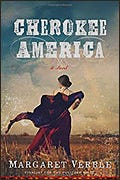Cherokee America is the name of a character in this novel, and also a statement about the nature of the story. In the years after the Civil War, Cherokee memories were only a few decades old of the "Trail of Tears," the forced removal in the 1830s of Cherokees from their lands in the American Southeast westward to Louisiana Purchase territory in what is now Oklahoma. The final forced march in the winter of 1839 is estimated to have killed some 5,000 Cherokee.
In the 1870s, resentment against the U.S. government lingered; but many Cherokee had married white Americans, and a new mixed-race generation had grown up who lived as Cherokee but had ties to white relations. Although fiction, Cherokee America was inspired by the life of a real woman who befriended the author's grandmother, and the story carries all the complexity of real Cherokee lives as they adapted to a new situation and resisted U.S. government pressures to give up their tribal sovereignty and adopt the customs of white America.
Cherokee America tells a sometimes hair-raising story of danger and struggle. "Chick," as the main character is called by her friends and family, is striving to raise her five sons to be strong and ethical men. Meanwhile, the husband she loves lies on his deathbed, her cook's husband has fathered an illegitimate child, and her second-eldest son's secret explorations are leading him into a dangerous and intensely shaming situation. Even with all this drama, much of the novel's fascination and depth comes from its depiction of the Cherokee culture in the 1870s. Here, in contrast to the white society pressuring it to abandon its traditions, women held considerable power and people bent over backward to respect each others' privacy. (2019; 385 pages including an Author's Note discussing the history behind the novel)




